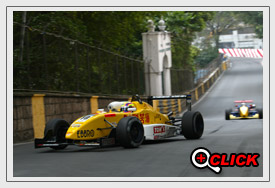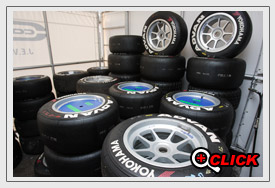Unlike the current race format, the combined times from two races, called as Leg 1 and Leg 2, made the final classification of the Grand Prix in those days. In Leg 1, Kataoka was fighting hard with Fabio Carbone for third but he spun when he was approaching to Lisboa Bend side-by-side with the Brazilian. To make matters worse for him, his engine wouldn't start again, so he had no choice but to retire. Starting Leg 2 from the bottom end of the grids, Kataoka's rapid recovery seemed to lead to a surprising top six finish in the second leg but his race abruptly ended with a crash.
gAs for the first leg, it happened when Carbone and I were approaching to Lisboa side-by-side. I was on the outside but I went too close to the guard rails, putting my tires on a very dusty part on the edge of the track. As a result, I spun on the spot and tried to rejoin but my starter motor didn't work! It was really a bad luck but I had to give up the race.h
gThe combined time race meant I had to start the second leg from the dead bottom of the grids and I was already a few laps down from the leader. So I had nothing to lose and drove just on the limit. But eventually I crashed my car when I had moved up to sixth or so.h
gI had no regret after the race. But I still think only if the starter had worked and I had rejoined in the first leg, I would have finished the leg without being lapped and my race in the second leg would have come out differently.h

After going through his memory of the race, we asked him, 'If Tatsuya Kataoka lives in 2013 can give a brief advice to himself in Macau ten years ago, what do you say?'
gWell, I would say, 'Get going from a point well before the limit.' The young drivers tend to be too aggressive, so I would tell him to take a steady and safe approach. I am not sure how this approach would have had influence on my lap times then but I guess, if I knew it, the things would have gone differently in my race.h
In 2003, the Japanese F3 Championship races were run on the other manufacturer's control tires. This meant that he, as a competitor in the championship, drove a F3 car with Yokohama Tire's product for the first time in the Macau Grand Prix weekend.
gIt was simply impossible to compare those two tires I used in that year because the Japanese championship races were held only at the permanent race circuits, while we drove on the street track in Macau. But I remember I had an impression, at that time, that the tires provided a good grip level even on the public road type surfaces. They were also very controllable and I didn't have any difficulty at all with the change of manufacturer to Yokohama Tire.h

It goes without saying that nowadays Kataoka is active as a professional racing driver in various categories in Japan and overseas, including the Super GT series. As the last question, we asked him what does that experience in Macau mean in his splendid racing career to date.
gFor me at that young age, the Macau F3 Grand Prix was so exiting experience, which gave me some mental confidence. I had opportunities to drive around the famous daunting race tracks, such as Nurburgring or Sarthe Circuit in Le Mans, later in my career but, to me, Guia Circuit in Macau is simply incomparable with any other. It was a great experience for a young racing driver to race in Macau and what I learned then is still very valuable to me today.h
Macau Grand Prix tests the rising stars' skill and bravery. The laurels are there but you can reach them only after getting through the challenging street track between the walls and guard rails that create a lot of blind corners...